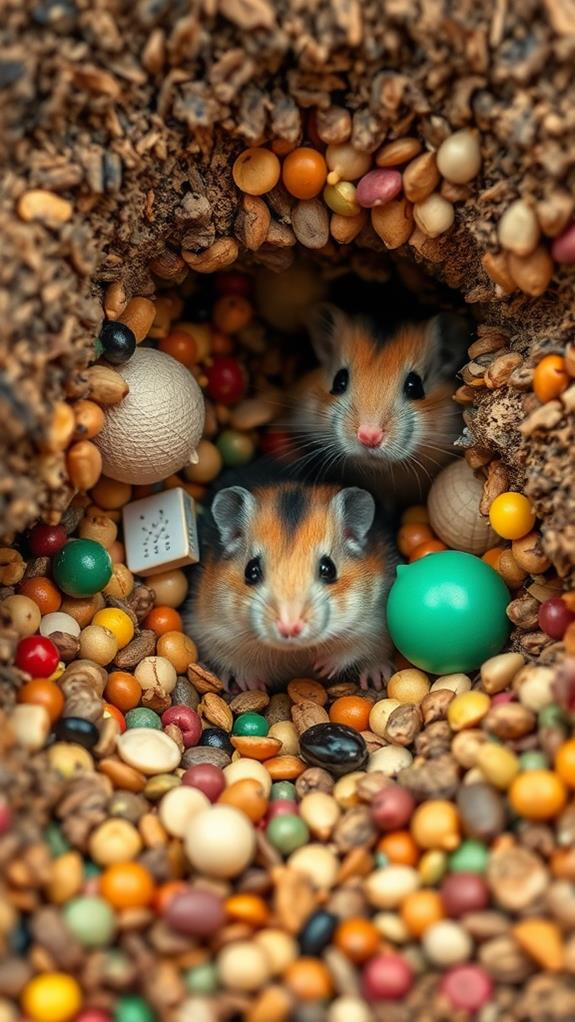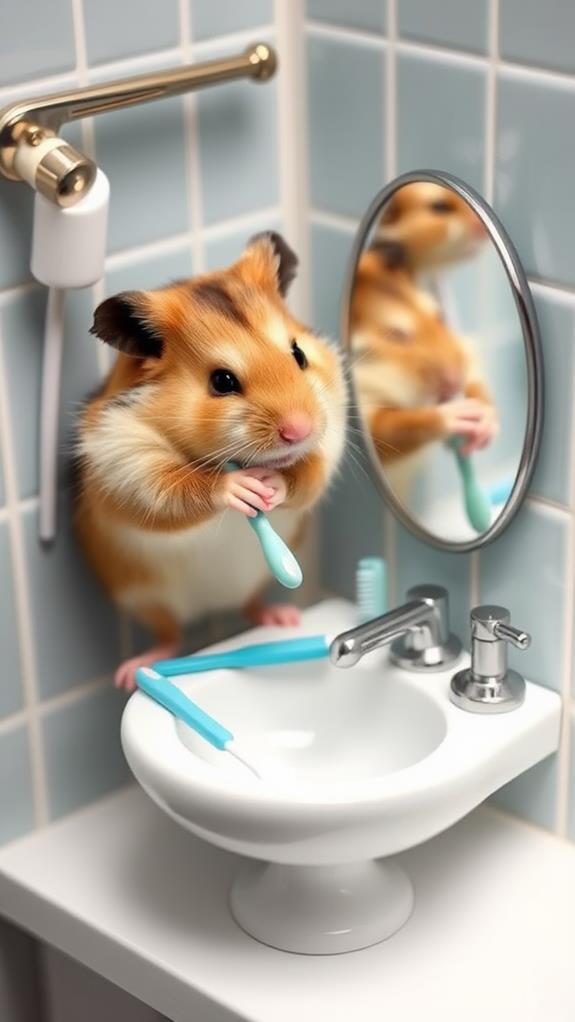Interesting Facts About Hamsters You Never Knew
Did you know that hamsters have a rich tapestry of hidden traits? These pocket-sized pets derive their name from the German word "hamstern," meaning to hoard. With over 600 species in their family, hamsters showcase impressive problem-solving skills and can navigate mazes efficiently. They're mostly nocturnal and solitary, preferring individual housing. Their poor eyesight is compensated by acute hearing and a keen sense of smell. Hamsters use their expandable cheek pouches to transport and store food, a survival instinct from their wild ancestors. Their average lifespan of 2-3 years can be extended with proper care and nutrition. Exploring further reveals even more intriguing aspects of these furry companions.
This post may contain affiliate links. If you make a purchase through these links, I may earn a commission at no additional cost to you. Additionally, portions of this post may be generated using artificial intelligence (AI) technology. While we strive for accuracy, please be aware that AI-generated content may not always be perfect and should be fact-checked when necessary.
The Spatula Scoops
- Hamsters can stuff their cheeks with food up to 20% of their body weight, thanks to expandable pouches extending to their shoulders.
- Some hamster species are capable of running up to 5 miles a night on their exercise wheels.
- Hamsters have the ability to see ultraviolet light, which aids in navigation during twilight hours.
- A hamster's teeth never stop growing, requiring constant gnawing to maintain proper dental health.
- Certain hamster species can lower their heart rate to just 4 beats per minute during hibernation.
Etymology and Hoarding Habits

Hamsters, with their adorable cheek pouches, are named for their defining characteristic: hoarding. You might not know this, but the term "hamster" comes from the German word "hamstern," which literally means to hoard. This etymology perfectly captures these little creatures' natural instinct to gather and store food.
When you observe hamsters, you'll notice their remarkable cheek pouches. These expandable pockets allow them to transport and store large quantities of food for later consumption. It's a survival tactic that's deeply ingrained in their behavior, common across various hamster species.
As a hamster owner, you should provide ample space in their habitat to accommodate this hoarding instinct. It's vital for their mental and physical well-being. By offering proper diet options and opportunities to hoard, you're engaging their natural behaviors and keeping them happy.
Understanding this aspect of hamster behavior is essential for their care. When you see your hamster stuffing its cheeks full of food, remember that you're witnessing an ancient survival mechanism in action. It's not just cute; it's a fundamental part of their nature.
Species Diversity and Classification

With over 600 species in the family Cricetidae, hamsters represent a diverse group of rodents. You might be surprised to learn that there are approximately 25 recognized species of hamsters globally, each with its own unique characteristics and adaptations. The most common pet hamster you'll encounter is the Syrian hamster, often called the "teddy bear" hamster due to its size and friendly nature.
Hamsters are classified into several genera, including Mesocricetus for Syrian hamsters and Phodopus for dwarf hamsters. This classification is essential for pet owners, as different species have varying care requirements. For instance, some dwarf hamsters are social animals that can live in pairs, while Syrian hamsters are solitary and should be housed alone.
When choosing pet hamsters, it's important to take into account the specific needs of each species. Wild hamsters, such as European and Turkish varieties, have behaviors and adaptations that differ greatly from their domesticated counterparts. Understanding these differences can help you provide the best care for your chosen hamster species, ensuring a happy and healthy pet.
Lifespan and Longevity Factors

Longevity in hamsters is influenced by a variety of factors, with the average lifespan typically ranging from 2 to 3 years. You'll find that proper nutrition plays an essential role in your hamster's health and longevity. A balanced diet, tailored to your hamster's specific needs, can greatly impact their overall well-being and potentially extend their life.
Habitat cleanliness is another important factor affecting your hamster's lifespan. Regular cleaning and maintenance of their living space can reduce the risk of infections and stress-related illnesses. Additionally, providing enrichment activities and minimizing stressors in their environment can contribute to a longer, healthier life for your furry friend.
Don't underestimate the importance of regular veterinary check-ups. These visits can help identify and address health issues early on, potentially adding precious time to your hamster's life. It's worth noting that different hamster species may have varying lifespans, with some dwarf hamsters occasionally outliving their Syrian counterparts under ideal care conditions. By focusing on these key factors, you can help guarantee your hamster lives a full and healthy life.
Habitat Preferences and Behavior

As the sun sets, your hamster's natural instincts kick in. Hamsters are nocturnal creatures, becoming most active during twilight and nighttime hours. You'll notice your tiny friend exploring, foraging, and exercising when you're winding down for the day.
To cater to your hamster's habitat preferences, you'll need to provide plenty of space for exploration and burrowing. They love to dig tunnels, mimicking their wild behavior to escape predators. Cleanliness is important to these little creatures, so you'll find they often choose specific corners for their bathroom needs, making your cleaning routine easier.
Here's a quick guide to hamster habitat essentials:
| Requirement | Purpose | Examples |
|---|---|---|
| Space | Exploration | Large cage, playpen |
| Bedding | Nesting | Wood shavings, paper |
| Hideaways | Security | Tubes, houses |
Social Nature and Personality Traits

When it comes to hamsters' social nature, you'll find that most species are solitary creatures, with Syrian hamsters being particularly territorial and requiring individual housing. However, you might be surprised to learn that some hamsters can develop a bond with their caregivers, recognizing them through scent and sound over time. It's important to understand that each hamster has its own unique personality, which influences how much handling and interaction it enjoys, ranging from those who love gentle petting to others who prefer minimal contact.
Solitary vs. Social Behavior
Most hamsters are naturally solitary creatures, preferring to live alone rather than in groups. This characteristic is particularly pronounced in Syrian hamsters, which exhibit strong territorial behavior. If you're considering getting a hamster, it's important to understand that these pets are typically happiest when housed singly. Their solitary nature doesn't mean they can't form bonds with their human caregivers, though. Social interaction with you can be beneficial for your hamster's well-being, but it should be on their terms.
Individual personality traits play a significant role in how your hamster responds to interaction. Some may be more outgoing and enjoy frequent handling, while others might prefer minimal contact. It's vital to respect your hamster's preferences and provide an environment that suits their needs. While non-Syrian species may show different social behaviors, it's generally safer to house hamsters individually to prevent stress and potential aggression. Remember, even though hamsters are solitary animals, they can still recognize you through scent and sound, allowing for a unique bond between pet and owner. Observing and adapting to your hamster's personality will help guarantee a happy, healthy pet.
Recognizing Individual Personalities
Every hamster has its own unique personality, just like humans do. As you spend time with your furry friend, you'll notice distinct traits that make them special. Some hamsters are naturally curious and outgoing, while others might be shy or reserved. Understanding these individual personalities is essential for building a strong bond with your pet.
To recognize your hamster's unique character, gentle handling and gradual social interactions are key. These small creatures often identify their caregivers through scent and sound, so consistent, calm interactions will help them feel comfortable around you. It's vital to remember that while most hamsters are solitary by nature, some species, like dwarf hamsters, may display more social tendencies.
As a responsible pet owner, you should observe your hamster's behavior closely. Pay attention to their likes and dislikes, as these preferences greatly influence their happiness and well-being. By taking the time to understand your hamster's individual personality, you'll be better equipped to provide an environment that suits their specific needs and temperament, ensuring a happy and healthy pet.
Intelligence and Learning Capabilities

Your hamster's intelligence may surprise you, as these small pets are capable of impressive problem-solving and learning. They can recognize their names, respond to basic commands, and even navigate mazes with proper training and positive reinforcement. What's more, hamsters' adaptability to training and their strong memory allow them to learn from past experiences, making them more responsive to their environment and caregivers over time.
Problem-Solving Abilities
Despite their small size, hamsters possess impressive problem-solving abilities that often surprise their owners. These tiny rodents can navigate mazes and puzzles with remarkable efficiency, showcasing their capacity to learn and adapt to their environment. You'll find that hamsters are quick to understand the layout of their habitat, remembering key locations for food, water, and hiding spots.
Their problem-solving skills are evident in various behaviors:
- Solving basic puzzles to access food rewards
- Finding innovative ways to escape or explore their enclosures
- Remembering complex routes within mazes or multi-level habitats
You can enhance your hamster's cognitive abilities by providing stimulating toys and challenges. This not only engages their natural problem-solving instincts but also improves their overall well-being. As you interact with your hamster, you'll notice they're capable of recognizing your scent and voice, further demonstrating their adaptability and learning potential.
Name and Command Recognition
Hamsters' cognitive abilities extend beyond problem-solving to include name and command recognition. You might be surprised to learn that these small rodents, known for their constantly growing teeth and eating a lot, can actually recognize their names and respond to simple commands. This showcases their capacity to associate specific sounds with actions, demonstrating a level of intelligence that many pet owners underestimate.
When you call your hamster's name, you may notice it perking up or coming towards you. This isn't just coincidence; hamsters can learn to recognize their names through consistent repetition and positive reinforcement. You can train your hamster to respond to commands by using treats as rewards, a technique known as operant conditioning in animal behavior studies.
It's important to note that not all hamsters will show the same aptitude for learning. Just like humans, these tiny pets have individual personalities and varying levels of intelligence. Some may quickly pick up on name recognition and commands, while others might take more time. Engaging your hamster in training sessions not only helps develop its cognitive abilities but also strengthens your bond with your pet.
Adaptability to Training
Building on their name and command recognition abilities, hamsters demonstrate remarkable adaptability to training. These small pets can learn a variety of tricks and behaviors through consistent practice and positive reinforcement. You'll find that using treats as rewards during training sessions can greatly enhance your hamster's learning experience and encourage desired behaviors.
To maximize your hamster's potential, consider incorporating the following elements into your training routine:
- Interactive toys and puzzles to promote problem-solving skills
- Simple obstacle courses or mazes to challenge their cognitive abilities
- Regular training sessions to reinforce learned behaviors and introduce new ones
Mental stimulation is essential for your hamster's overall well-being, as it keeps their minds active and engaged. By providing a stimulating environment and consistent training, you'll help your furry friend thrive both mentally and physically.
Remember that hamsters recognize their caregivers through scent and sound, which can aid in the training process. As you work with your pet, you'll develop a stronger bond, making training sessions more effective and enjoyable for both of you. With patience and persistence, you'll be amazed at how adaptable and intelligent your hamster can be.
Dietary Requirements and Preferences

Generally, hamsters require a balanced diet to thrive in captivity. As omnivorous creatures, they need a variety of foods to meet their dietary requirements. You'll want to provide a mix of commercial pellets, fresh fruits, and vegetables to guarantee they're getting all the necessary nutrients. Remember, treats should make up no more than 10% of their overall intake.
When offering fresh foods, it's essential to choose safe options. Here's a quick guide to help you:
| Safe Foods | Unsafe Foods |
|---|---|
| Spinach | Chocolate |
| Apples | Caffeine |
| Carrots | Onions |
| Cucumber | Garlic |
Hamsters have an interesting adaptation: cheek pouches. These allow them to transport and store food, tapping into their natural hoarding instinct. You'll often see your hamster stuffing its cheeks full of food to save for later.
Don't forget about hydration. Always provide fresh water, changing it daily to guarantee your hamster stays healthy and well-hydrated. By following these guidelines, you'll help your hamster maintain a balanced diet and ideal health in captivity.
Grooming and Hygiene Practices

When it comes to grooming and hygiene, you'll find that hamsters are surprisingly tidy creatures. They naturally keep their habitats clean by designating specific areas for waste, making your job of maintaining their environment much easier. While you'll need to remove waste daily, a thorough habitat cleaning is only necessary about once a month.
To support your hamster's grooming habits, consider these key points:
- Provide suitable bedding materials like shredded paper or Timothy hay
- Offer dust baths for certain species to help maintain clean, oil-free fur
- Avoid using strong chemical cleaners that could irritate their sensitive respiratory systems
When cleaning your hamster's habitat, it's vital to use pet-safe products and maintain a consistent cleaning schedule. This not only guarantees a healthy environment but also supports your hamster's natural instincts. Some hamster species benefit from dust baths, which act as a dry shampoo, helping to keep their fur clean and free from excess oils. By providing appropriate bedding and maintaining a clean habitat, you're supporting your hamster's grooming needs and promoting overall hygiene. Remember, a clean habitat contributes greatly to your hamster's health and happiness.
Do Bobcats and Hamsters Share Any Surprising Similarities?
While bobcats and hamsters differ drastically in size and habitat, both are crepuscular, meaning they are most active during dawn and dusk. This shared behavior helps them avoid predators and adapt to their environments. For more captivating insights, explore interesting facts about bobcats and their fascinating survival tactics in the wild.
Sensory Abilities and Adaptations

While hamsters excel at keeping themselves clean, their sensory abilities are equally impressive. These small rodents have adapted to their environment in fascinating ways, compensating for their limited vision with other heightened senses.
You might be surprised to learn that hamsters have poor eyesight. However, they're not completely blind. They can distinguish between light and dark, which helps them navigate during their nocturnal activities. To make up for this visual limitation, hamsters rely heavily on their other senses. They possess an acute sense of smell, using scent glands to mark their territory and communicate with other hamsters. This olfactory prowess allows them to recognize familiar scents and detect potential threats.
Your hamster's sensitive hearing is another vital adaptation. They can pick up high-frequency sounds that you can't hear, making verbal cues from you an effective way to interact with them. Additionally, their whiskers serve as important sensory tools. These specialized hairs help hamsters feel their way around in low-light conditions, providing spatial awareness and helping them avoid obstacles. By understanding these sensory adaptations, you can better cater to your hamster's needs and create a more comfortable environment for them.
Frequently Asked Questions
What Are 5 Interesting Facts About Hamsters?
You'll be amazed by these hamster facts. First, they can run up to 5 miles in one night on their wheels. Second, their average lifespan is 2-3 years. Third, they have expandable cheek pouches that reach their shoulders for food storage. Fourth, their teeth grow continuously, requiring regular chewing to maintain dental health. Finally, hamsters are nocturnal creatures, preferring quiet, dim environments during the day. These unique characteristics make hamsters fascinating pets to observe and care for.
What Are the Dark Facts About Hamsters?
You might be surprised by some dark facts about hamsters. They can carry zoonotic diseases like salmonella, which pose risks to humans, especially children and those with weakened immune systems. In Hawaii, hamster ownership is banned due to their potential to disrupt ecosystems. Syrian hamsters, the most common pets, are aggressive and can't be housed together. Their continuously growing teeth can lead to dental issues if not properly managed. Sadly, European hamsters are critically endangered, with populations declining by over 80% due to human activities.
What Are the Unique Traits of Hamsters?
You'll find that hamsters possess several unique traits. They have expandable cheek pouches for carrying food, and their teeth grow continuously. These little creatures can run impressive distances, covering up to 5 miles in a night on exercise wheels. With poor eyesight, they rely on their keen sense of smell and sensitive whiskers to navigate. Many species, especially Syrian hamsters, are solitary and territorial. Their distinct characteristics make them fascinating pets with specific care requirements.
Do Hamsters Recognize Their Name?
Did you know that 90% of hamster owners report their pets responding to their names? You'll find that hamsters can indeed recognize their names over time. Through consistent interaction and positive reinforcement, you can train your hamster to associate its name with attention or treats. Remember, they rely on smell and sound, so your scent and voice play an essential role. While individual responses may vary, most hamsters can learn this basic association with patience and regular training.





